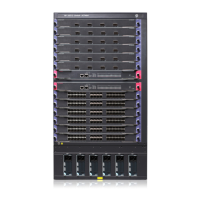354
Ste
Command
Remarks
5. Enter interface view.
interface interface-type
interface-number
N/A
6. Enable OSPFv3 on the
interface.
ospfv3 process-id area area-id
[ instance instance-id ]
By default, OSPFv3 is disabled on
an interface.
Perform this configuration on PEs.
Configuring IPv6 IS-IS between PE and CE
An IPv6 IS-IS process belongs to the public network or a single VPN instance. If you create an IPv6 IS-IS
process without binding it to a VPN instance, the process belongs to the public network.
For more information about IPv6 IS-IS, see Layer 3—IP Routing Configuration Guide.
To configure IPv6 IS-IS between PE and CE:
Ste
Command
Remarks
1. Enter system view.
system-view N/A
2. Create an IPv6 IS-IS process
for a VPN instance and enter
IS-IS view.
isis [ process-id ] vpn-instance
vpn-instance-name
Perform this configuration on PEs.
On CEs, create a normal IPv6 IS-IS
process.
3. Configure a network entity
title for the IS-IS process.
network-entity net Not configured by default.
4. Enable the IPv6 capacity for
the IS-IS process.
ipv6 enable Disabled by default.
5. Return to system view.
quit N/A
6. Enter interface view.
interface interface-type
interface-number
N/A
7. Enable the IPv6 capacity for
the IS-IS process on the
interface.
isis ipv6 enable [ process-id ] Disabled by default.
Configuring EBGP between PE and CE
1. Configure the PE:
Ste
Command
Remarks
1. Enter system view.
system-view N/A
2. Enable BGP and enter BGP
view.
bgp as-number N/A
3. Enter IPv6 BGP-VPN instance
view.
ipv6-family vpn-instance
vpn-instance-name
N/A
4. Configure the CE as the VPN
EBGP peer.
peer ipv6-address as-number
as-number
N/A
5. Redistribute the routes of the
local CEs.
import-route protocol [ process-id ]
[ med med-value | route-policy
route-policy-name ] *
A PE must redistribute the routes of
the local CEs into its VPN routing
table so that it can advertise them
to the peer PE.

